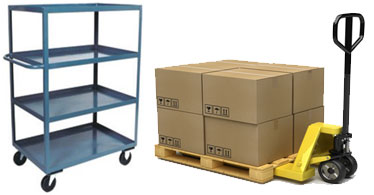Hand Carts vs. Pallets for Retail Distribution
When it makes sense to pick to carts

Retail distribution facilities have multiple options for shipping product to store locations. They can send full pallets which must be unwrapped, unloaded, and stocked at the store location. They can send packed carts that can easily be rolled onto store floors and stocked at the point of sale. What method works best?
Like most things worth debating, this depends on the application, the load and the situation. Hand carts are typically best for small order sizes per store. Pallets hold the advantage for larger orders, in particular where the pallets can be cubed out to maximize shipping efficiency.
Carts: why and when they work for retail distribution
Order picking carts usually are more ergonomic and faster to-shelf at the point of retail. For purposes of this article, they are usually multi-tier shelf type carts that allow pickers to dedicate an entire cart to one store. They’re easier for drivers to unload and for store personnel to transport, as they can roll directly off a truck, be checked in, and roll to the floor or storage back room for putaway. Pallets don’t have to be opened, broken, stored or moved at the store, with its typically limited backroom space. Also, this eliminates or reduces the need for stretch wrap.
More work at the DC, less at the store
Carts also reduce the need for material handling equipment at stores. If orders are always fulfilled by cart, there is no need for a forklift, stacker, or pallet jack, so stores have less need for pallet moving equipment.
Carts may allow you to more easily mix cases and totes than pallets. Pallets may require a tote with hinge lid or other means to make the tote stackable for shipment.
 At the DC, order pickers can roll the same cart to picking locations. This can be much faster than picking to a pallet or into a cart to then be palletized later.
At the DC, order pickers can roll the same cart to picking locations. This can be much faster than picking to a pallet or into a cart to then be palletized later.
Depending on the type and size of order cart, you can get many more into a truck trailer (estimate 24 carts vs. 14 pallets onto a standard trailer). This allows a trailer to serve many more locations than a palletized load could, depending on how many carts are needed per-store.
Some downsides
On the flip side, carts consume more staging space at both distribution centers and stores, particularly if there are multiples. Carts are also mechanical and will break down over time. You’ll be replacing casters, maintaining carts, and replacing them over time. If your system requires both pallets and carts, the carts add to complexity at the dock when compared to a pallets-only approach.
Carts are also more expensive than pallets, so they carry an initial capital investment that is higher than palletizing. You must also consider that for stores that have loading docks, pallets are easier to unload from trailer to store. Pallets excel more at pure case-pick applications which are easier to cube and allow more cases per shipment to be processed.
Considerations may also include the cost of loading carts compared to the cost of loading pallets at the distribution level. This isn’t a one size fits all situation. Either method may cost more, given a DC layout, WMS system, and other considerations. You’ll also have to store carts during non-peak times, and they simply take up more space in storage than pallets do. This can be alleviated by purchasing nestable and/or stackable carts.
Also, carts must be returned to the DC and can become a bottleneck if the flow of carts between store, DC, and back isn’t optimal.
One key is flexibility of design. Your order picking area should be designed so that it can accommodate carts, pallets, or a mixture. At times you’ll want to change the methodology and building the aisles and picking areas so that they are capable of handling either will pay off in the end.
Tags: warehousing, order fulfillment, Retail distribution, Safety & Ergonomics
Scott Stone is Cisco-Eagle's Vice President of Marketing with 35 years of experience in material handling, warehousing and industrial operations. His work is published in multiple industry journals an websites on a variety of warehousing topics. He writes about automation, warehousing, safety, manufacturing and other areas of concern for industrial operations and those who operate them.




